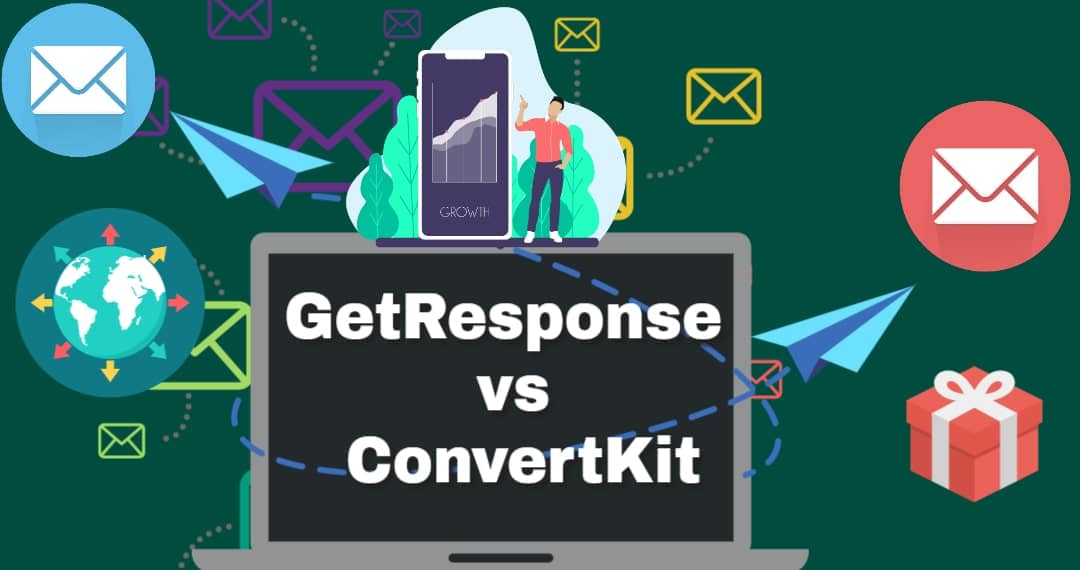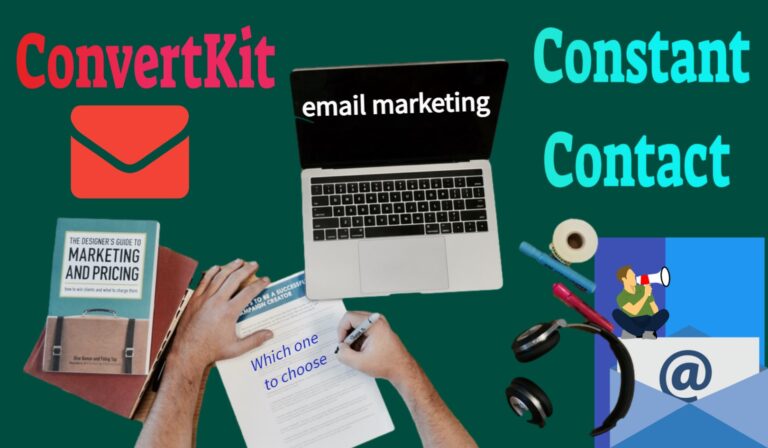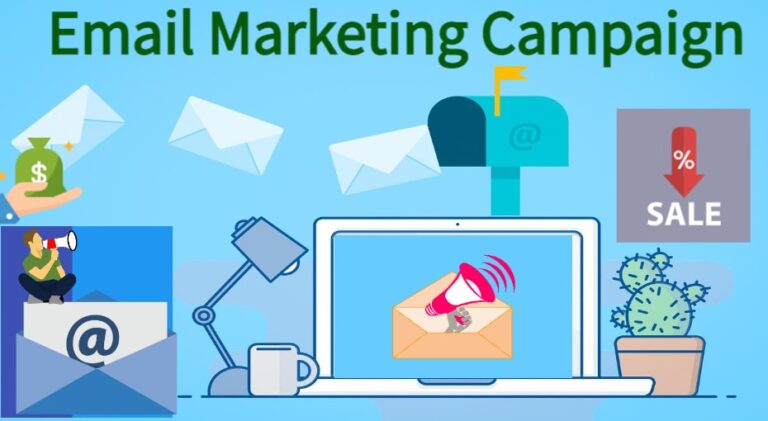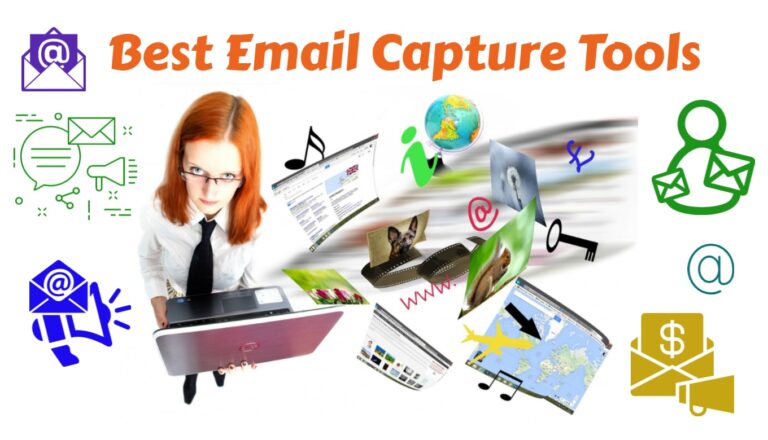GetResponse vs ConvertKit: Which is a Better Email Marketing Service? (2022)
GetResponse vs ConvertKit
Probably, your hunt for the perfect email and lead generation tool has led you here at GetResponse vs ConvertKit comprehensive Comparison.
Which path will deliver your business’ success? You could go with ConvertKit, which promises impressive delivering results.
Or you might choose GetResponse —which provides all the key components you’d expect from an email marketing platform.
Both GetResponse and ConvertKit provide unparalleled service that can improve every aspect of your sales funnel from nurturing leads to closing deals faster than ever before!
How do I make this decision without knowing details about their services? Let’s think practically … What are some core needs we have when choosing between these two services?
These two marketing automation tools, Getresponse and Convertkit, both are capable of growing your email lists and nurturing contacts.
In addition to this, they help sell more products or services. The biggest difference between them would be their features – so let’s compare those first …
GetResponse vs ConvertKit: Main Differences

Let’s first see a few major differences between GetResponse and ConvertKit before we go into detail:
- You’ll get charged for duplicate sign-up at GetResponse, but not at ConvertKit.
- ConvertKit does not offer specialized Webinar automation, autoresponder, or workflows builder, whereas GetResponse does.
- ConvertKit is good for signing up subscriptions unlike GetResponse, which is ideal for salespeople.
When we start digging into these products (GetResponse vs ConvertKit), you started noticing their differences, right?
From what I’ve seen, GetResponse is better for businesses in the B2B market while ConvertKit spares no expense when it comes to helping small teams.
You will have a better understanding by the end of this article about GetResponse vs ConvertKit.
We’ll help you make your decision, but it’s ultimately up to you. You know what’s best for yourself and that is why we want this choice of yours to be made by yourself alone.
So, below are the detailed analysis that will help you should decide when trying to pick between GetResponse vs ConvertKit.
Let’s get started!
1. Marketing automation: GetResponse vs ConvertKit
GetResponse

GetResponse’s suite of marketing automation tools makes it easy to import contacts from other platforms. One way is by using a CSV file or another provider’s API integration.
The platform also has an automated verification process that helps you avoid double-counting your audience.
GetResponse helps marketers create professional email marketing campaigns using pre-built templates and triggers.
There are two options on the main dashboard: “quick actions,” which has all of these features. Or you can take advantage of everything in the suite through a more detailed menu system.

When you need eCommerce integrations, GetResponse has your back. Their marketing automation workflows can send transactional emails, abandoned cart sequences, and product recommendations to customers.
These automated messages will be sent using triggers such as a customer reaching the end of their trial or purchasing items that fulfill specific criteria. Even if you are new to marketing automation, it is easy and straightforward.
Your first step would be to join the interactive tutorial on how everything works before moving forward. There are also a few pre-designed templates that can help get you started as well.
Utility of Marketing Automation
Marketing automation can be an excellent tool for beginners who need quick access to information.
The marketing automation workflow triggers an abandoned cart email to be sent. Depending on your choice, you can build workflows from scratch at any time.
For example, if a customer abandons his/her cart, then the marketing automation workflow triggers sending an email to that particular person.
This is very useful in many ways because such kinds of emails are highly effective and convert readers into customers most efficiently.

Have you ever wanted to create a marketing automation campaign that requires specific elements and conditions?
If so, then it’s time for your needs. Lots of users love the drag-and-drop feature in marketing automation.
It’s not only easy to use but also flexible, allowing users to build custom parameters for their needs.
ConvertKit: Marketing Automation

On the other hand, ConvertKit also has a variety of marketing automation tools. They aim at keeping complex workflows simple.
Not only does GetResponse have a drag-and-drop builder, but ConvertKit also has these features too. With this feature, they’ll help you build your follow-up emails and marketing campaigns.
It ( ConvertKit) gives you the option of using one of their pre-made templates. Dragging and dropping are easy for those who are new or unsure where to start with automation.
They can simply use one of the ready-made templates and begin their work. However, it can be limiting at times, especially if what they need isn’t on offer.

Evergreen newsletters are a great way to attract new subscribers, right? You can easily customize the path in case you want to change an event, condition, or action.
GetResponse has specifically designed its marketing automation tools to fit seamlessly into your workflow. This is a huge advantage when compared with ConvertKit.
While both GetResponse and ConvertKit have a range of marketing automation capabilities, the latter has more. That’s a conversion funnel feature (we’ll talk more about it later).
This makes it easy to determine which automated email sequence you need in certain circumstances. Unfortunately, this is not available with ConvertKit yet.
2. Landing page capabilities on GetResponse vs ConvertKit
GetResponse
GetResponse allows you to create a landing page with its Landing Page Creator. You can easily build one to promote your business.
The 100+ templates allow for quick customization, and the ability to make one from scratch leaves room for creative freedom.

You’ll find that you have a lot of flexibility in their drag-and-drop editor. If you choose to use this editor, then they’ll have a range of options for customizing text and images. You can also add any CSS, HTML, or Javascript code if desired.
And it doesn’t stop there–if you’d like external content such as your Twitter feed or countdown timer working in tandem with the rest of your website design, this is doable through that same feature too.
What you can do with their landing page creator?
With their landing page creator, you can also perform several actions described below:
- Adding content blocks for text, image, video, etc.
- The landing page has a preview option to see what it looks like on desktop or mobile devices.
- Collection of payments, with their PayPal integration
- Adding webinar registration forms
- With the countdown timers, you can add a sense of urgency
- Structure your landing pages using sections
- Adding static and pop-up forms
- Social sharing icons can be added
It’s easier than ever to edit your landing page because you can now alter the title and URL of each element on it.
This makes your pages more discoverable by search engines, so people will be able to find them. They also make sure that every template is mobile responsive.
This way users who visit from a smartphone or tablet device won’t have any problems viewing/using these templates either.
GetResponse integrates with analytical tools like Google Analytics and Google Tag Manager. So, your page will have a better chance of showing up in search results (SERPs).
GetResponse also provides the tools to A/B test landing pages using their built-in A/B testing functionality. You can split-test which call-to-action button or lead magnet is converting more leads.
Finally, with their marketing suite, you can use the landing page as a webinar registration and grow your email list even faster.
ConvertKit
ConvertKit also has a landing page builder and pre-made templates.
But comparing between GetResponse vs ConvertKit, ConvertKit has a lot lesser templates than its counterpart.
You get 100+ templates in GetResponse but about 18 templates only in ConvertKit. However, it is needless to say that both offer quality templates.
GetResponse’s drag-and-drop landing page editor allows you to create, change and update your online pages in a matter of minutes.
While ConvertKit uses more of a static approach with elements that cannot be moved around the design but instead are fixed in their place.

In addition to being easy to use, the templates you get from both of them are well built. If you find one you like, editing it is a breeze — drop boxes and tags make things less complicated.
To collect leads without a website? Yes, you can use these landing pages to build your contact list and sell products.
3. Email marketing: GetResponse vs ConvertKit
GetResponse
GetResponse is a powerful email marketing platform that helps you create effective campaigns and put them on autopilot. The power of GetResponse comes from combining two important features:
- 1) automated lead nurturing efforts
- 2) easy-to-create email campaigns.
This allows marketers to focus more time on creating content instead of manually sending emails, which can take hours out of your day. How you’re going to achieve it?
By creating email drip campaigns (autoresponder), you can send your subscribers relevant and timely information with ease.
You can use their readymade templates to create these campaigns quickly. Or you can even start from scratch if that’s what works best for you.
To help visualize when each campaign will hit the subscriber’s inboxes in relation to one another they have an intuitive calendar view.

GetResponse knows your contacts so well that it can adjust the send-time of a campaign based on time zone. This means you don’t have to worry about when is the best time for them.
Now, the GetResponse email marketing suite gets to know what’s important to your business because it gets to know your contact by their data. That’s cool, right?
They use this information to help you grow by automatically sending email campaigns at just the right times without having to do anything manually.
ConvertKit
ConvertKit is a great email marketing platform because it keeps things simple. Unlike other services, you only have the option to add text, images, and GIFs instead of full templates or drag-and-drop features for faster editing.
ConvertKit believes that less is more when creating emails so that there are fewer distractions from your message. They believe this will give you better chances of converting leads into customers.
However, there are some limitations when using the drag and drop feature on ConvertKit. Even if you want to add extra elements, there’s no dragging and dropping.
You’re limited by an editor where adding in new items feels like a word processor–just as it does with Google Docs.
ConvertKit lets you edit email marketing funnels by clicking on them in the workflow:

Editing email in Convertkit is easy
Comparing the landing page between GetResponse vs ConvertKit, they have more or less similar features.
Hence, it’s easy to tie in elements and then get the most out of its email marketing features as well. You have limited customization options as compared with GetResponse though.
4. Conversion funnels: Getresponse vs ConvertKit?
GetResponse
Comparing between GetResponse vs ConvertKit, the former is more than just an email marketing tool. It goes into a full-blown marketing machine.
GetResponse has everything you need to create a custom conversion funnel, like the ones below:
- Sales pages
- Landing Pages
- Stores
- Payment processors
- Follow-up/abandoned cart emails
- Social Ads creator
- Instagram Ads
- Facebook Ads
With this funnel tool, you can see what’s missing from your marketing strategies. Simply pick a template and it will tell the elements to add to each stage of your sales process.
The templates are even better because they help visualize the process for each stage of sales management.

GetResponse Conversion Funnels do more
GetResponse has a whole range of conversion funnel templates that can be used to create email sequences and landing pages.
The steps also come with helpful templates, so you won’t need to spend hours building the funnels manually. The customer journey from clicking to buying is an important one.
With GetResponse conversion funnels, you are able to track a complete trail of events that lead up until the purchase itself.
By understanding this process fully and having access to all previously used data on your customers, it becomes easier for marketers like us.
Now you can strategize how you can best serve your audience in times when they’re looking at making their next purchases.
Because you have the conversion funnel tracking every step of your customers’ footprints. It allows you to change up parts that aren’t working and optimize those that are.
By using GetResponse, you can create a suite of marketing tools that covers everything from email to analytics.
In the past, most marketers had to use multiple different platforms and services for their marketing needs.
But now with all these features under one roof in the GetResponse platform— it makes things much easier.
Conversion Funnel of ConvertKit
Getresponse vs ConvertKit: Which conversion funnel is better?
In this comparison between Getresponse and Convertkit, we’ve seen a number of things that GetResponse does well. The same happens here too.
One of ConvertKit’s most prominent features is its ability to automate your workflow. Unfortunately, it doesn’t have a conversion funnel feature like GetResponse.
If you want an effective way to monitor conversions from different parts of your site or online activity then choose GetResponse.
5. Webinar: Getresponse vs ConvertKit
GetResponse
Currently, GetResponse is considered to be the only major email service provider on the market to offer webinar software.
If you’ve any idea about others as sophisticated as GetResponse, please tell us in the comment.
Launching a webinar using GetReponse will give you access to features like:

- multiple hosts
- recording
- screen sharing/interactive chat room
- surveys and Q&A session
- Facebook and YouTube streaming options
- design tools and interactive whiteboard, etc.
With Widget, you’ll have the option to choose from a variety of webinar room layouts and features. You can use these options to make your presentation more engaging for viewers:
Setting up a webinar is easy and quick. Once you’ve set the URL, date, and time for your event, you’re ready to launch.
All that’s left to do is sit back as attendees tune in from their phones or computers with no problems on any device.
Finally, the GetResponse survey tool can be used to gather feedback at the end of each webinar. Since it is linked with other marketing platforms, automated follow-up sequences can be based on their responses.
ConvertKit
ConvertKit is an email marketing tool suited for bloggers and small businesses that want to grow their audience.
If you want to host a webinar, ConvertKit can integrate with other tools like WebinarJam and Crowdcast. Your potential clients can attend the events through their preferred service or app.
But if you’re looking for an all-inclusive tool, it doesn’t have its own dedicated platform. So, the final decision lies upon you whether you feel that comfortable or not.
6. Pricing Comparison: GetResponse vs ConvertKit
GetResponse
GetResponse has a wide variety of plans with prices that vary by the number of features, list size, and budget. There is something for everyone.
Their most popular plan is the Plus option because it offers just enough without overcharging customers who don’t need extensive features.
You can choose from three different pricing tiers plus a Max plan. This Max plan price is based on your website’s monthly visitors (AKA “list size”).
They offer customizable options to suit any business’ needs. If you decide to join, they’ll reward your choice with a discount.
You get an 18% off if you choose the one-year plan and 30% if choosing on or two-year plans. The best part, sign-up now and get a completely 30-day free trial.
ConvertKit
ConvertKit, the company behind many favorite blogging tools (the email list builder) has now moved on to become a full-fledged marketing platform.
It has a free version although with limited features but still worth it, especially for beginners or new bloggers. What would you need more?
Their most popular plan is $29/month for up to 1000 subscribers and unlimited scheduled emails.
You can try the app out for 14 days to see if it’s right for you with no credit card info required.
But, the automation and integrations features are only available on paid versions. The two popular plans include Creator and Creator Pro.

If you are serious about growing your email list and nurturing customers using automated sequences, you’ve to go for the paid version.
The free plan is great for businesses just starting out, but it’s not enough to support professionals.
So, comparing ConvertKit vs GetResponse in terms of paid plans, the latter will be a better option in my personal opinion.
You’ll also get no discount nor offer even if you purchase a one-year plan or two-year plan.
7. Ready-made templates on GetResponse vs ConvertKit
GetResponse
GetResponse has a variety of free email templates that will suit any type and size of business.
Additionally, it also offers an Email Creator where you can create your own design from scratch.
Let’s begin with their templates.

You no longer need to worry about your email templates looking outdated as the library is regularly updated with new and innovative design styles.
Never will you have a problem sending an engaging, interesting message across any device because this template works well on all devices including smartphones or tablets.
Want to make your email a little more engaging? Customize your template with text, video, and images. You can add custom code too if you know how to.
With the email creator, you can change anything from font size to the color of links–and even use HTML if that’s what suits your brand best.

With GetResponse creator, you can do the following:
- Add content blocks for text, images, videos, and buttons
- Using sections you can easily structure your emails
- You can preview your email to make it look perfect on mobile devices
- Sections can be saved for future product launches or campaigns
- Customize emails with your brand’s logos, fonts, etc.
- Using HTML you can add custom-code elements
- Finally, spam-check your message before sending it out
So, GetResponse features above make it easier to customize your emails so that they look professional in the subscribers’ inboxes. Not only that but also significantly improve customers’ engagement.
If one wants to go beyond a template they are able to opt for an HTML feature, it’ll let you customize your email for more complex projects.
Templates of ConvertKit
ConvertKit is one of a few email marketing services that does not use templates. As a result, the builder looks somewhat similar to Gmail or your regular word processor.
It allows you to write emails like normal and insert images and other elements by dragging them into place rather than having pre-built layouts.
You can try ConvertKit Visual Email Template editor. You don’t need to know any code or HTML, you just have to pick a template and create beautiful custom email templates.
However, some other users complain about having less control over design elements when compared to others such as GetResponse.
The problem with most email templates is that they’re not designed for e-commerce marketers.
ConvertKit thinking is that the more elements you put into an email, the less likely it can reach your subscriber’s inbox.
While this may work well for some, many online sellers could probably prefer ready-made templates that are designed to drive conversion.
Want to create a custom email template, but don’t feel comfortable working with code? You can try ConvertKit Visual Email Template editor.
No need to know any HTML or coding – just pick a template and build beautiful templates.
8. Bloggers’ Choice: GetResponse vs ConvertKit
GetResponse
GetResponse has created several tools to help bloggers stay focused and effective in their messaging. These include:
- RSS-to-email tool
- An email creator with ready-made-templates
- Web push notifications
- Lead magnet funnels.
- Social ads creator
- Both Sign-up and popup forms
- Facebook and Instagram ads
ConvertKit
ConvertKit is a great fit for bloggers. Do you know why? Bloggers understand bloggers, which is why many bloggers choose to use ConvertKit. Do you know why?
The straight answer to the above similar questions is – because it was built by fellow bloggers.
Bloggers can schedule their emails according to the time they reach an audience on what days and times are best for them. There are several ways you can filter your list using ConvertKit.
You could use tags, date subscribed, segments or their first name to send broadcasts and RSS feeds only to specific audiences. The RSS feed of ConvertKit can also be easily customized.

The main differences between GetResponse vs ConvertKit for bloggers are that the latter only has 18 landing pages to choose from.
If you need a platform with more options, this might not be enough. ConvertKit is a great email service provider but lacks the conversion funnel feature.
It may be harder for bloggers to convert subscribers after they land in their funnel. Thus, making ConvertKit less valuable than other providers like GetResponse.
9. Which one will let you Tag Subscribers?
GetResponse
GetResponse lets you automatically tag and segment lead based on their behavior.
You don’t have to manually go through all the data in order to compile lists for different segments.
Here, GetResponse will do it itself by tagging any subscriber who opens certain types of messages or clicks specific links as per your instructions.
All you need then is an autoresponder that automates sending campaigns according to these tags so that only interested users receive those emails.

A marketing automation workflow assigns points to recipients based on their behavior. The image above is an example of how it works.
Leads who have been assigned more points are likely going to turn into a customer and those with less are not as valuable in terms of sales.
This level of segmentation helps you target leads that have higher chances of turning them into customers
ConvertKit
GetResponse and ConvertKit are both email marketing services that allow you to tag subscribers and create rules for your subscribers.
This feature is not limited to GetResponse only. You can also send out a specific offer to certain groups if you want.
With its list management tools, you can easily create rules that will apply discounts to certain groups of people.

Once you add tags to your contact, the information will be displayed in the feed
10. Workflows of GetResponse vs ConvertKit
GetResponse
GetResponse’s visual workflow builder necessitates you to map out email automation with different triggers.
You can create a sequence that targets frequent customers who didn’t convert after an earlier webinar or people who attended the webinar but haven’t made any purchases yet.
This is also one important factor GetResponse retained its subscribers.
Look at the workflow builder below:

GetResponse has a nifty feature (workflow builder) that allows you to add “triggers” based on conditions.
For example, if someone subscribes to your email list they can be prompted with an automated sequence of emails created by the workflow builder
You can also add triggers in your marketing automation for events such as:
- email opens
- clicks on links
- URL visited
- abandoned carts
- new subscribers,
- product purchases as well as upgrades
You can use these triggers to create and customize your onboarding sequences, cart abandonment campaigns, and reactivation campaigns.
These are great ways to boost engagement with customers or increase sales.
ConvertKit
To increase engagement, ConvertKit has a few workflows you can use to automate certain actions.
For example, they have triggers for ‘events’, which will send out an email at whatever time the subscriber is most likely to open it. This works even if they are on mobile or another device.
There are also ‘actions’ and conditions that help with drip campaigns by sending content depending on what stage of your sales funnel someone is in.
Below is the workflow of what ConvertKit looks like:

As we mentioned earlier, ConvertKit makes it easy to customize the content inside these workflows by allowing you to edit triggers and emails on one screen.
Instead of taking you into another window or tab as other software does, this feature allows for a more efficient workflow process that will save time in your day-to-day activities:
As we said before…ConvertKit made it so simple. They make it easy to customize the content inside these workflows by allowing you to edit triggers and emails on one screen.
Instead of taking you into another window or tab like other software does, this feature allows for a more efficient workflow process that will save time in your day-to-day activities.
Now THAT’S efficiency!
11. Web push notifications: GetResponse vs ConvertKit
GetResponse
Web push notifications are like text messages but for websites. They allow you to interact with website visitors via their browser, even if they aren’t on your site right now!
GetResponse allows businesses to send these useful and engaging messages through both desktop web browsers and mobile devices.
Web push notifications can be sent anytime the user has an open window in their browser – no matter how big or small it is!”

ConvertKit
GetResponse vs ConvertKit is a comparison of two similar email marketing platforms that also have many differences in features.
Even in this case, GetResponse offers web push notifications, while ConvertKit does not have this feature built-in.
However, it doesn’t mean you’re completely restricted or void of sending web push notifications from your site.
You can use a dedicated service like Push Push Go for this purpose because ConverKit integrates with the same.
Further, ConvertKit integration with Zapier also allows you to get email notifications for all new subscribers, regardless of which form they were subscribed on.
You can also receive emails when a subscriber makes certain purchases through ConvertKit or other third-party eCommerce platforms.
12. Which is preferable to run Facebook and Google ads?
GetResponse
Social media ads can be a huge boon for bloggers, freelancers, and small businesses because they allow you to build your audience.
However, it has become a significant barrier for them to create engaging ads to draw new customers.
You might also have seen many ads on your social media channel, too much, right? So, it’s not a simple task to run a productive ad with thousands of competitors.
Fortunately, GetResponse has two tools that will help with this problem: our Social Ads Creator and Facebook Ads creator.
You can easily create and publish both image and video ads straight from Getresponse with the new tools they have available.
All you need is a ready-made template, which will make your ad professional-looking when launched directly onto Facebook or Instagram.
Using pre-made templates, you can have an ad up in minutes. Once you’ve launched your ad, it’s easy to track engagement rates from inside of the GetResponse dashboard.
You can also automatically add Facebook Pixel tracking code on all landing pages. You can use the same code to retarget potential customers with more ads from the same (GetResponse) dashboard.
ConvertKit
ConvertKit doesn’t provide a feature to run either Facebook ads or Google ads.
But it is possible to add your Facebook pixel on your landing page.
Every time visitors come from one of those campaigns they will be added to your custom audiences in the ad manager or campaign manager.
Imagine no more time wasted uploading and downloading CSVs. ConvertKit automatically manages your Facebook custom audiences for you.
It is just one of many new updates this tool offers its customers who have subscribed to the Creator Pro plan.
ConvertKit has made customer journeys easier by directly integrating with Facebook Custom Audiences to simplify ad management without having to spend hours exporting and importing data.
GetResponse vs ConvertKit: Full Feature Comparison
GetResponse Offer!
If you don’t like the paid plan, you can subscribe to the free plan below:
Final thoughts on GetResponse vs ConvertKit
We finally come to the concluding part of our comparison between GetResponse vs ConvertKit. With email marketing, you need to get the right tool for your needs.
It required a lot of time and effort research to be done. Luckily, all the hard work has been done for you so that you can make a judicious decision.
When evaluating each product, it’s important not only to look at the features they offer but also which one will fit with your existing tech stack and budget plan.
In our comparison of GetResponse vs ConvertKit, both have many great options that can suit different needs depending on what part of any company’s workflow you are currently in.
GetResponse is an option that comes with plenty of good reviews from other users in many different industries.
On the other hand, ConvertKit has targeted audiences and is higher in cost than what some businesses initially expect. But, it’s a good choice for beginners for their online business.
Based on our comparison, which is more suitable and fulfills your need. The answer to this completely rests upon you.
Thank you!







